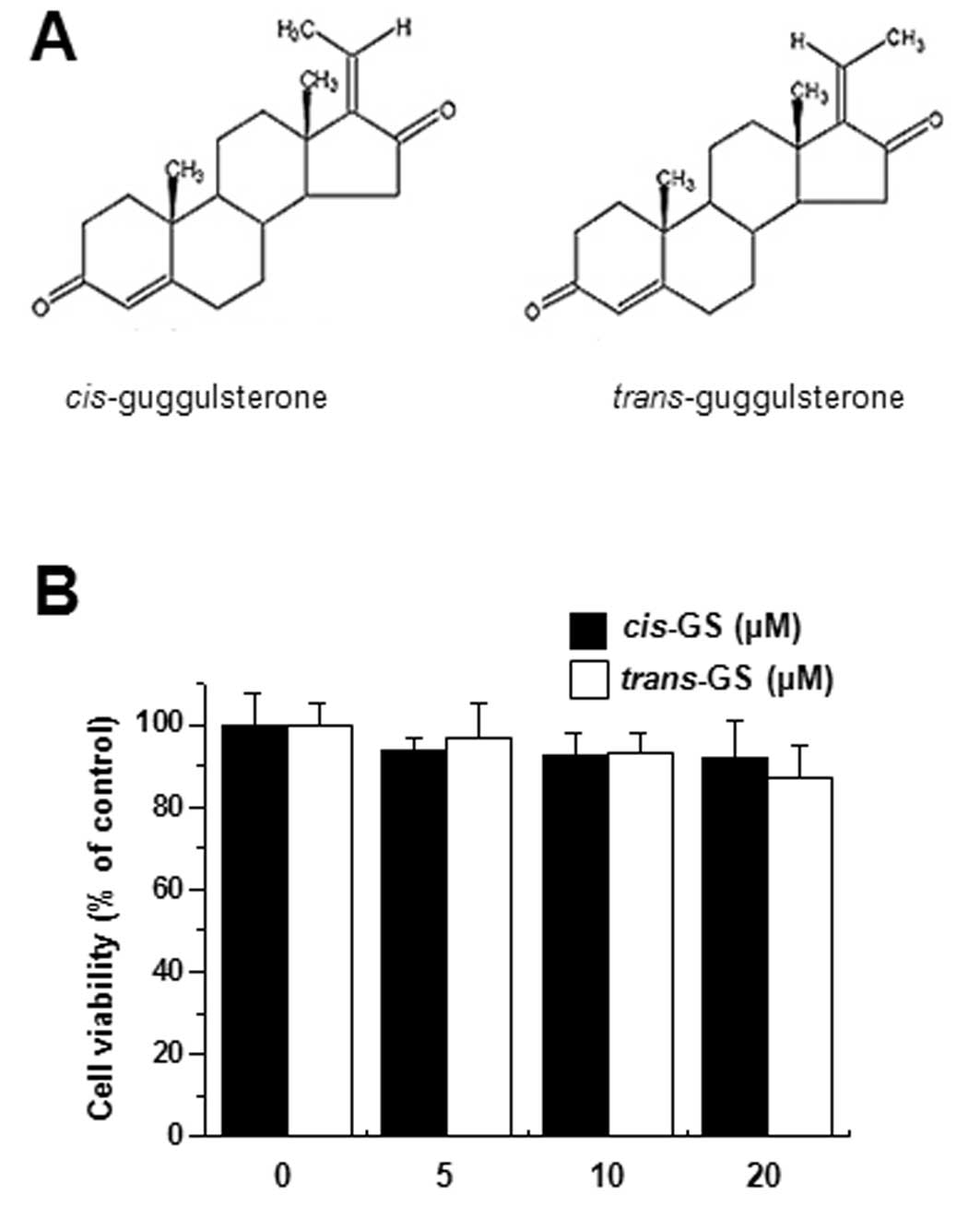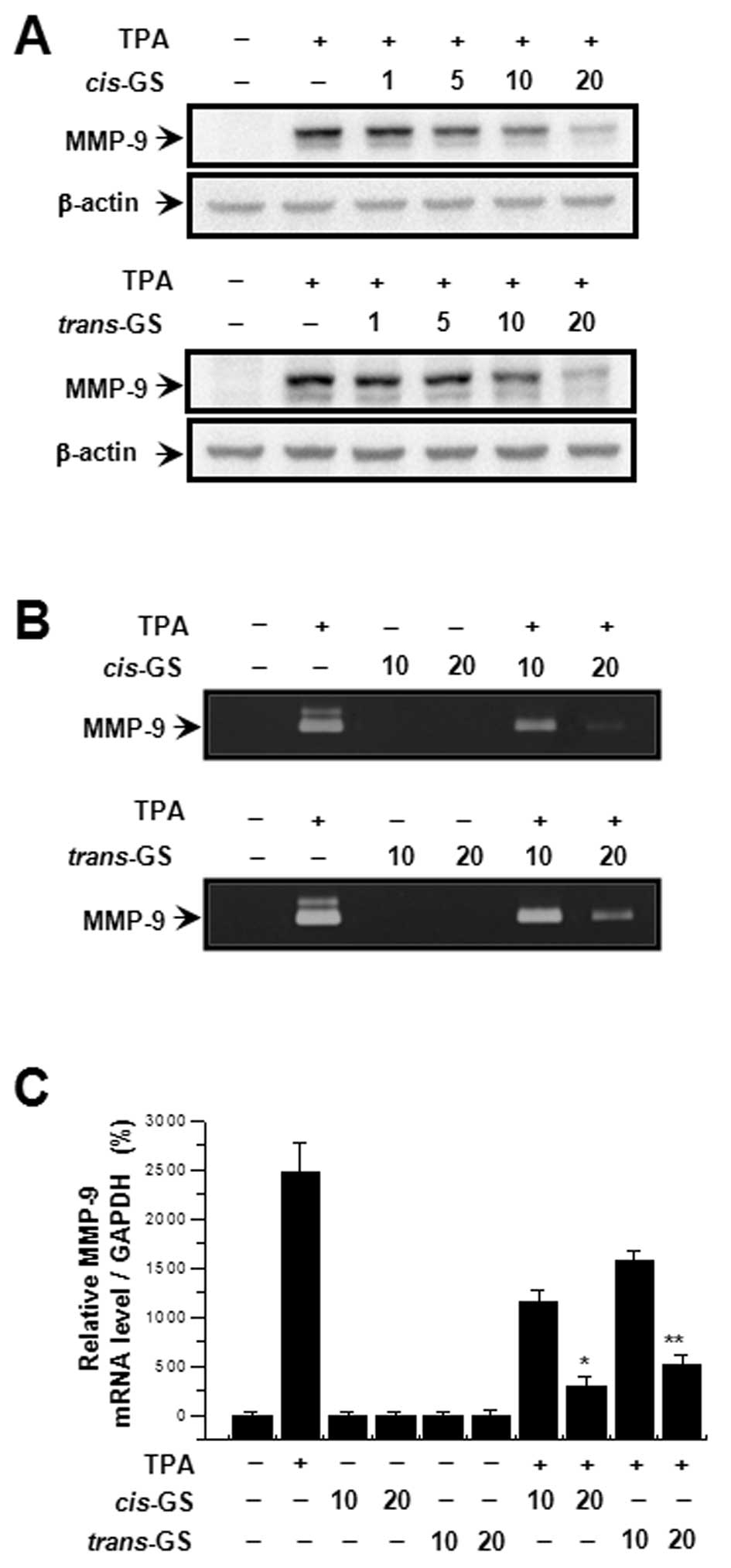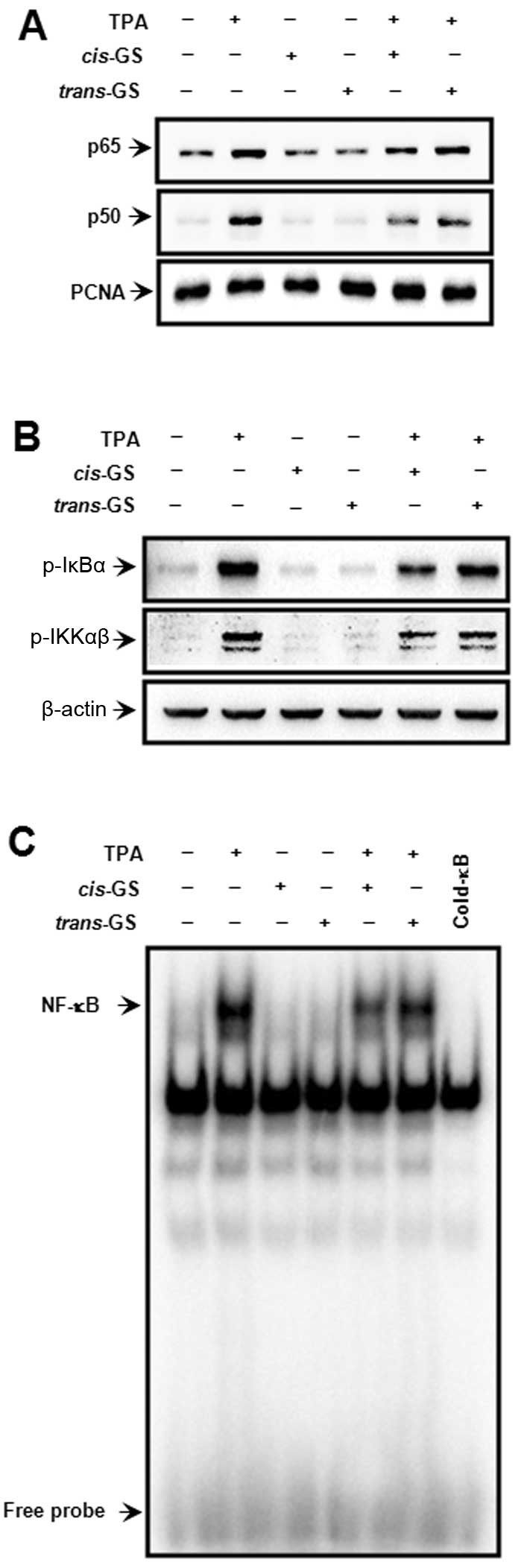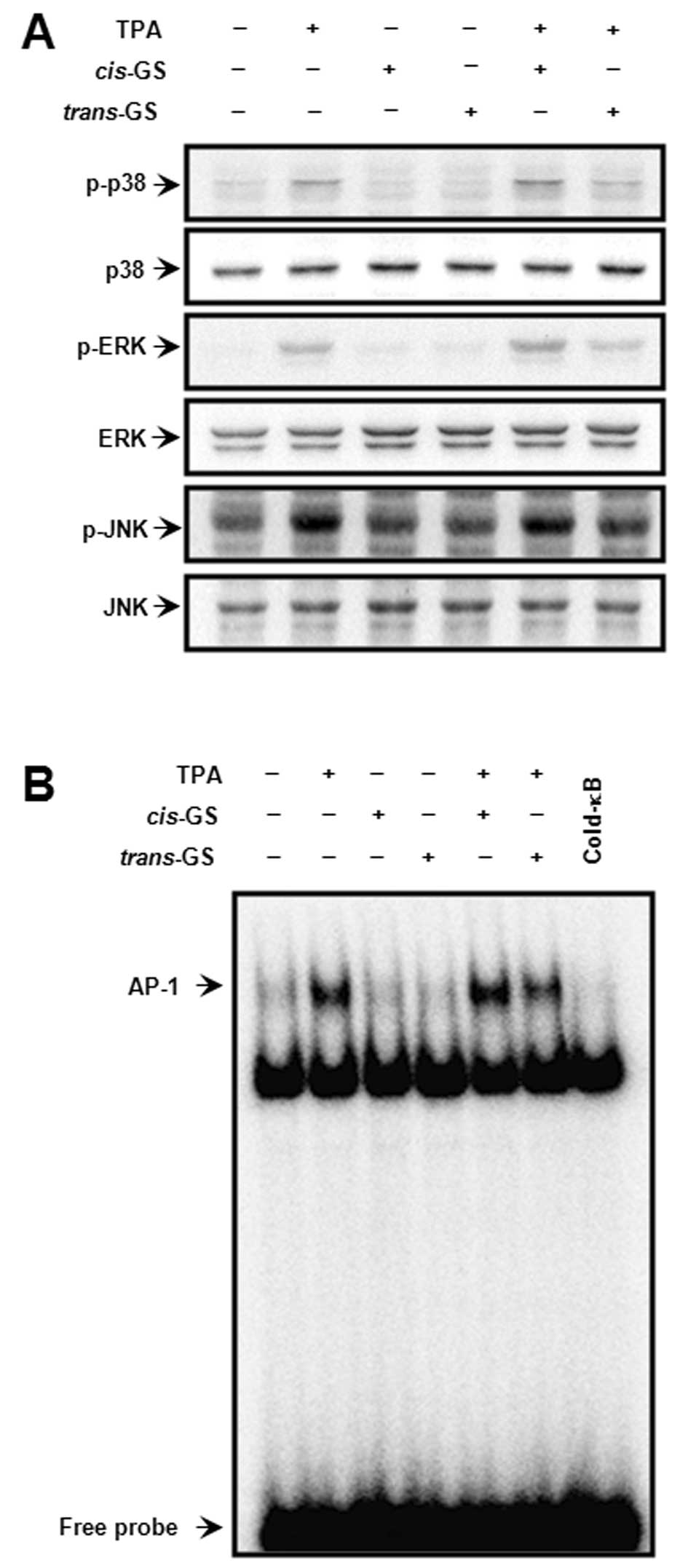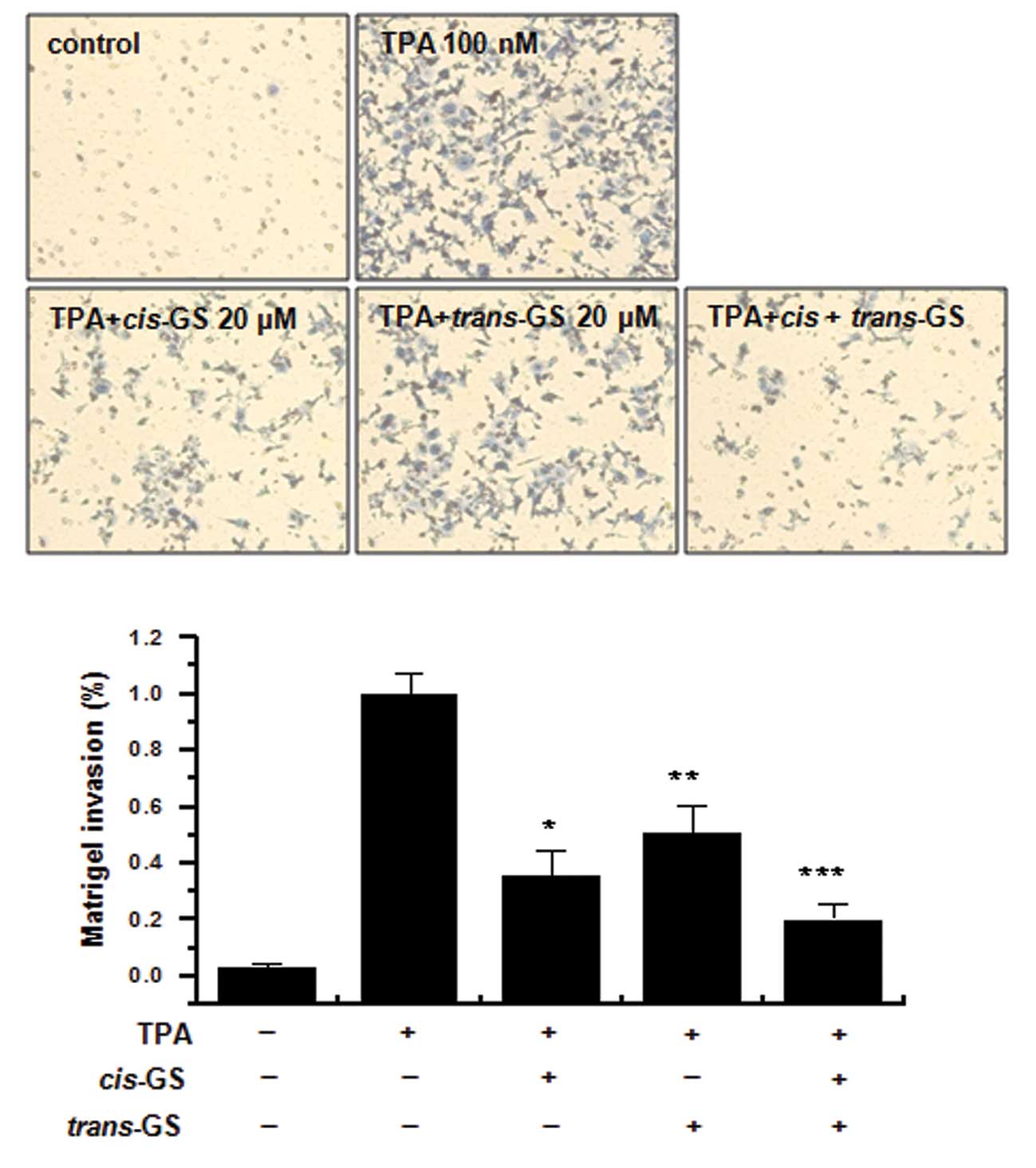Cis-guggulsterone inhibits the IKK/NF-κB pathway, whereas trans-guggulsterone inhibits MAPK/AP-1 in MCF‑7 breast cancer cells: Guggulsterone regulates MMP‑9 expression in an isomer-specific manner
- Authors:
- Published online on: December 14, 2012 https://doi.org/10.3892/ijmm.2012.1214
- Pages: 393-399
Abstract
Introduction
Guggulsterone [4,17(20)-pregnadiene-3,16-dione], is a plant sterol derived from the gum resin (guggulu) of the tree Commiphora mukul. This gum resin has been used for centuries in Ayurvedic medicine to treat obesity, arthritis and hyperlipidemia (1,2). The anti-arthritic, anti-inflammatory and anti-lipid activities of guggulsterone have also been demonstrated (3). Recently, guggulsterone has been shown to exhibit antitumor activity in a variety of human tumor cell types (4). The active compound in the resin is cis and trans isomers of guggulsterone (3,5). Of note, cis-guggulesterone is more potent than the trans-isomer in inducing apoptosis in mature adipocytes (3). Furthermore, guggulesterone isomers have been shown to exhibit isomer-specific antitumor activity (6–8). However, the molecular mechanism of guggulesterone-mediated anticancer activity remains elusive.
Invasion processes require the degradation of the extra-cellular matrix (ECM), which provides biochemical and mechanical barriers to cell movement in cancer (9). Studies have reported that in the matrix metalloproteinase (MMP) family, gelatinases A (72 kDa gelatinase, type IV collagenase and MMP-2) and B (92 kDa gelatinase, type IV collagenase and MMP-9) play a critical role in ECM degradation and cell migration leading to tumor cell invasion in breast cancer (10,11). Elevated MMP-9 levels have been functionally linked to elevated metastasis in a number of tumor types, such as brain (12), prostate (13), bladder (14) and breast tumors (15,16). Consequently, inhibiting the expression of MMP-9 and/or its upstream regulatory pathways may prove to be effective in treating malignant tumors, including breast cancer.
Protein kinase C (PKC) is involved predominantly in the production of MMP-9 (17–21). A PKC activator, 12-O-tetradecanoylpho-bol-13-acetate (TPA), induces MMP-9 synthesis and secretion during various pathological processes, such as tumor invasion (16,22). TPA-mediated MMP-9 expression is regulated by activating transcription factors, such as nuclear factor-κB (NF-κB) and activator protein-1 (AP-1) in cancer cells (23–25). The mitogen-activated protein kinase (MAPK) signaling pathway is important for AP-1 activation and NF-κB activation requires IκB kinase (IKK), phosphoinositide 3 kinase-Akt, or p38 MAPK, depending on the cell type (17–21). Consequently, these findings suggest that the main pathways involved in MMP-9 expression following PKC activation are the MAPK, NF-κB and AP-1 pathways.
In this study, we investigated the roles of guggulsterone isomers in regulating TPA-induced MMP-9 expression, and thus suppressing cell invasion, as well as the mechanisms involved.
Materials and methods
Cells and materials
MCF-7 cells were obtained from the American Type Culture Collection (Manassas, VA, USA). Cells were cultured in DMEM supplemented with 10% fetal bovine serum (FBS) and 1% antibiotics at 37°C in a 5% CO2 incubator. Isomers of guggulsterone were obtained from Steraloids Inc. (Newport, RI, USA) and dissolved in dimethyl sulfoxide (DMSO). TPA, 3-(4,5-dimethyl-thiazol-2-yl)-2,5-diphenyltetrazoliumbromide (MTT), and anti-β-actin antibodies were from Sigma (St. Louis, MO, USA). Antibodies against p-IκBα, p-IKKαβ, p38, p-p38, JNK, p-JNK, ERK and p-ERK were from Cell Signaling Technology (Beverly, MA, USA). MMP-9, p50, p65, proliferating cell nuclear antigen (PCNA) and horseradish peroxidase (HRP)-conjugated IgG antibodies were from Santa Cruz Biotechnology Inc. (Santa Cruz, CA, USA). High glucose-containing DMEM, FBS and phosphate-buffered saline (PBS) were purchased from Gibco-BRL (Gaithersburg, MD, USA).
Determination of cell viability
The effect of guggulsterone on MCF-7 cell viability was determined using an MTT assay (26). Briefly, cells were seeded at 3×104 cells/well and allowed to attach. After 24 h, cells were treated with guggulsterone at 5, 10 or 20 μM. After incubation for 24 h, cells were washed with PBS. MTT (0.5 mg/ml PBS) was then added to each well, and the plates were incubated at 37°C for 30 min. Formazan crystals were dissolved with DMSO (100 μl/well), and an intensity of color was detected at 570 nm using a microplate reader (Model 3550; Bio-Rad, Richmond, CA, USA).
Western blot analysis
MCF-7 cells (5×105) were pre-treated with guggulsterone (10 and 20 μM) for 1 h and then incubated with TPA for 24 h. Cells were lysed with an ice-cold lysis buffer (50 mM Tris-HCl, pH 7.4, 1% NP-40, 0.5% sodium deoxycholate, 150 mM NaCl, 1 mM EGTA, 0.1% SDS). Protein concentration was determined using the Bradford method (27). Samples (20 μg) were separated by SDS-PAGE with 10% acrylamide, and the resolved proteins were transferred onto a hybond-PVDF membrane using a western blotting apparatus. The PVDF membrane was incubated with 2% bovine serum albumin or 5% skim milk to block non-specific sites, and then incubated overnight with 1 μg/ml primary antibody for MMP-9, p38, p-p38, JNK, p-JNK, ERK, p-ERK, β-actin, p50, p65, or PCNA. HRP-conjugated IgG was used as the secondary antibody. Protein expression levels were determined by signal analysis using an image analyzer (Fujifilm, Tokyo, Japan).
Gelatin zymography assay
The conditioned medium was collected after 24 h of stimulation with TPA, mixed with non-reducing sample buffer, and separated on a polyacrylamide gel containing 0.1% (w/v) gelatin (25). Gels were washed at room temperature for 30 min with 2.5% Triton X-100 solution, and incubated at 37°C for 16 h in 5 mM CaCl2, 0.02% Brij and 50 mM Tris-HCl (pH 7.5). The gel was stained for 30 min with 0.25% (w/v) Coomassie brilliant blue in 40% (v/v) methanol/7% (v/v) acetic acid and photographed with an image analyzer (Fujifilm). Proteolysis was imaged as a white zone in a dark blue field. Densitometric analysis was performed using Multi Gauge Image Analysis software (Fujifilm).
Quantitative real-time PCR assay
Total RNA was extracted from the cells using a FastPure RNA kit (Takara Bio Inc., Shiga, Japan). The RNA concentration and purity were determined by absorbance at 260/280 nm. cDNA was then synthesized from 1 μg total RNA using the PrimeScript RT reagent kit (Takara Bio Inc.). MMP-9 and GAPDH mRNA expression were determined by real-time PCR using the ABI PRISM 7900 sequence detection system and SYBR®-Green (Applied Biosystems, Foster City, CA, USA). Primers used were: MMP-9 (NM-004994) sense, CCTGGAGACCTGAGAACC AATCT and antisense, CCACCCGAGTGTAACCATAGC; and GAPDH (NM-002046) sense, ATGGAAATCCCATC ACCATCTT and antisense, CGCCCCACTTGATTTTGG. To control for variation in mRNA concentration, all the results were normalized to the housekeeping gene, GAPDH. Relative quantification was performed using the comparative ΔΔCt method according to the manufacturer’s instructions.
Preparation of nuclear extract
The MCF-7 cells (2×106) were treated with guggulsterone in the presence or absence of TPA for 4 h. Cells were immediately washed twice with PBS (pH 7.5), scraped into 1.5 ml of ice-cold PBS, and pelleted at 1,500 × g for 3 min. Cytoplasmic and nuclear extracts were prepared from cells using the NE-PER® Nuclear and Cytoplasmic Extraction Reagents (Pierce Biotechnology, Rockford, IL, USA).
Electrophoretic mobility shift assay (EMSA)
The activation of NF-κB and AP-1 was assayed with a gel mobility shift assay using nuclear extracts. An oligonucleotide containing the κ-chain (κB, 5′-CCGGTTAACAGAGGGGGCTTTCCGAG-3′) or the AP-1 (5′-CGCTTGATGAGTCAGCCGGAA-3′) binding site was synthesized and used as a probe for gel retardation assay. Two complementary strands were annealed and labeled with [α-32P]dCTP. Labeled oligonucleotides (10,000 cpm), 10 μg of nuclear extracts, and a binding buffer [10 mM Tris-HCl, pH 7.6, 500 mM KCl, 10 mM EDTA, 50% glycerol, 100 ng poly(dI•dC), 1 mM DTT] were incubated for 30 min at room temperature in a final volume of 20 μl. Reaction mixtures were analyzed by electrophoresis on 4% polyacrylamide gels in 0.5X TBE buffer (final concentrations: 22.5 mM Tris-borate, pH 7.6, 0.5 mM EDTA). Gels were dried and examined by autoradiography. Specific binding was controlled by competition with a 50-fold excess of cold κB or AP-1 oligonucleotide.
Invasion assay
Invasion assays were carried out in 24-well chambers (8-μm pore size) coated with 20 μl Matrigel diluted in DMEM. The Matrigel coating was re-hydrated in 0.5 ml DMEM for 30 min immediately before the experiments. Cells (2×105 cells/well) were added to the upper chamber with chemoattractant in the bottom well. Conditioned medium (0.5 ml) was added to the lower compartment of the invasion chamber and chambers were incubated for 24 h. Following incubation, cells on the upper side of the chamber were removed using cotton swabs, and cells that had migrated were fixed and stained with toluidine blue solution. Invaded cells were counted in five random areas of the membrane under a light microscope. Data are presented as the means ± SE from three individual experiments performed in triplicate.
Statistical analysis
Statistical analysis was performed using ANOVA and Duncan’s test. A value of P<0.05 was considered to indicate a statistically significant difference.
Results
Effect of guggulsterone isomers on MCF-7 cell viability
Since the cytotoxicity of guggulsterone cis- and trans-isomers (Fig. 1A) on MCF-7 cells has not been previously reported, we examined the cytotoxicity to avoid interference from the reagent. The treatment of MCF-7 cells with guggulsterone isomers (5, 10 and 20 μM) for 24 h caused no significant change in cell viability (Fig. 1B).
Effect of guggulsterone isomers on TPA-induced MMP-9 expression in MCF-7 cells
In order to investigate the effect of guggulsterone on TPA-induced MMP-9 expression, we performed western blot analysis, real-time PCR, and zymography with MCF-7 cells. MCF-7 cells were treated with guggulsterone isomers (1, 5, 10 and 20 μM) in the presence of 100 nM TPA for 24 h. Western blot analysis revealed that the treatment of MCF cells with guggulsterone isomers blocked the upregulation of TPA-induced MMP-9 expression in a concentration-dependent manner (Fig. 2A). Determination of the effects of guggulsterone isomers on TPA-induced MMP-9 secretion revealed that both cis- and trans-isomers substantially inhibited TPA-induced MMP-9 secretion (Fig. 2B). Real-time PCR also showed that TPA increased the MMP-9 mRNA levels in MCF-7 cells, which was blocked by guggulsterone isomers in a dose-dependent manner (Fig. 2C). Of note, cis-gugulsterone decreased MMP-9 expression and secretion to a greater extent at 20 μM than trans-guggulsterone (Fig. 2A and B). These results indicate that the cis-isomer is more potent than the trans-isomer in the inhibition of TPA-induced MMP-9 expression and secretion in MCF-7 cells.
Effect of guggulsterone isomers on TPA-induced NF-κB activation
The MMP-9 promoter contains NF-κB and AP-1 binding sites, both of which are centrally involved in MMP-9 gene induction (23,24,28,29). To investigate the transcription factor involved in inhibiting MMP-9 transcription by guggulsterone, we first examined the effect of guggulsterone isomers on the TPA-stimulated NF-κB signaling pathway. The treatment of MCF-7 cells with guggulsterone isomers revealed that cis-isomer, but not trans-isomer, inhibited the TPA-stimulated nuclear translocation of p65/p50, an NF-κB subunit and NF-κB DNA binding activity (Fig. 3A and C), as well as the TPA-induced phosphorylation of IκBα (Ser-32) and IKKαβ (Ser-176/180) (Fig. 3B). These data indicate that inhibition of the TPA-stimulated activation of the IKK/IκB/NF-κB axis by guggulsterone is stereoisomer-specific and that cis-guggulsterone is an inhibitor of IKK.
Effect of guggulsterone isomers on TPA-induced AP-1 activation
MAPK signaling pathways are involved in the AP-1 transcriptional activity (29). We investigated the effect of guggulsterone on the TPA-induced activation of MAPK and AP-1 by western blot analysis and EMSA. The TPA-induced ERK, JNK and p38 phosphorylation, and the activation of AP-1 binding activity were detected (Fig. 4). The activation of the signaling molecules by TPA was significantly blocked by trans-guggulsterone, but not cis-guggulsterone, indicating that the inhibition of TPA-stimulated AP-1 activation by guggulsterone is also stereoisomer-specific; that is, trans-guggulsterone regulates TPA-mediated MAPK/AP-1 activation in MCF-7 cells.
Effect of guggulsterone isomers on TPA-induced MCF-7 cell invasion in vitro
The effects of guggulsterone isomers on the invasive potential of MCF-7 breast cancer cells were evaluated using a Matrigel invasion assay. Treatment with TPA increased MCF-7 cell invasion compared to the control MCF-7 cells. The incubation of MCF-7 cells with TPA resulted in a 10-fold increase in the invasion of MCF-7 cells. Treatment with cisguggulesterone decreased the TPA-induced cell invasion by 67%, and the trans-isomer reduced the invasion by 51% (Fig. 5). The combination of these isomers exerted an additive effect on the inhibition of MCF-7 cell invasion, showing a 79% inhibition of invasion.
Discussion
This study examined the effects of guggulsterone isomers (cis and trans) on TPA-induced cell invasion, MMP-9 expression and related molecular mechanisms in MCF-7 cells. We found that cis-guggulsterone inhibited TPA-induced MMP expression by blocking IKK/NF-κB signaling, whereas trans-guggulsterone by blocking MAPK/AP-1 signaling, suggesting that guggulsterone isomers differ in the modulation of TPA-induced MMP-9 expressions in MCF-7 cells. The combination of isomers exerted additive effects on the inhibition of MCF-7 cell invasion. This study is the first to show that the combination of guggulsterone isomers may be a potential therapeutic strategy for breast cancer.
NF-κB is a transcription factor that plays an important role in the induction of MMP-9 gene expression (30,31). NF-κB comprises a family of inducible transcription factors which regulate host inflammatory and immune responses (32). Diverse signal transduction cascades mediate NF-κB pathway stimulation (32). NF-κB is an inducible dimeric transcription factor that belongs to the Rel/NF-κB family of transcription factors and consists of two major polypeptides, p65 and p50 (33). NF-κB is initially located in the cytoplasm in an inactive form complexed with IκB, an inhibitory factor of NF-κB. Various inducers such as TPA, cytokines and stress can dissociate this complex, presumably by IκB phosphorylation, resulting in NF-κB being released from the complex. IKKαβ phosphorylates serine residues in the NH2-terminus of IκB, resulting in NF-κB release and translocation to the nucleus (30). NF-κB then translocates to the nucleus, where it interacts with specific DNA recognition sites to mediate gene transcription. The NF-κB elements are centrally involved in MMP-9 gene induction by TPA (23,34). Shishodia and Aggarwal (6) showed that guggulsterone suppressed NF-κB activation by inhibiting IKK and IκBα degradation in the majority of tumor cells. In support of these observations, we found that the TPA-stimulated phosphorylation of IKKαβ and IκBα and the nuclear translocation of NF-κB were inhibited by treatment with cis-guggulsterone, but not with trans-guggulsterone. These findings suggest that cis-guggulsterone is a specific inhibitor of the IKK/NF-κB pathway.
AP-1 is a sequence-specific transcriptional factor composed of Jun, Fos and ATF family proteins, which are induced by multiple stimuli such as TPA, cytokines, growth factors and stress (35). The MAPK signaling pathway plays a pivotal role in AP-1 activation (17–21). The activation of ERK results in an increase in AP-1 activity via c-Fos induction, whereas JNK activation leads to the c-Jun phosphorylation (17–21). In this study, the results showed that TPA-induced ERK, JNK and p38 phosphorylation, and AP-1 binding activity via c-Fos induction were blocked by trans-guggulsterone, but not by cisguggulsterone. These findings suggest that trans-guggulsterone is a specific inhibitor of the MAPK/AP-1 pathway.
MMP-9 activation has been shown to be associated with the progression and invasion of tumors, including mammary tumors (36). Thus, the discovery and development of an agent that inhibits MMP-9 expression are important for the treatment of cancer/tumors. Guggulesterone significantly diminished the TPA-induced cell invasion, and the combination of these isomers exerted additive effects on the inhibition of MCF-7 cell invasion. These results indicate that MMP-9 may be one of the critical molecules involved in processing tumor invasion and metastasis of breast cancer cells.
In conclusion, guggulsterone isomers downregulate MMP-9 expression and tumor cell invasion through the stereoisomer-specific suppression of IKK/NF-κB and MAPK/AP-1 activation. That is, cis-guggulsterone regulates the IKK/NF-κB pathway and trans-guggulsterone regulates MAPK/AP-1 activation. Therefore, guggulsterone isomers modulate TPA-induced MMP-9 expression in MCF-7 cells in an isomer-specific manner. Moreover, the combination of these isomers exerts an additive effect on inhibition of MCF-7 cell invasion. Based on these observations, we suggest that the combination of cis- and trans-guggulsterone isomers may be a strong candidate for the prevention of breast tumor invasion and metastasis.
Abbreviations:
|
TPA |
12-O-tetradecanoylpho-bol-13-acetate; |
|
MMP |
matrix metalloproteinase; |
|
IKK |
I-κB kinase; |
|
AP-1 |
activator protein-1; |
|
MAPK |
mitogen-activated protein kinase; |
|
ECM |
extracellular matrix |
Acknowledgements
This study was supported by the Korea Science and Engineering Foundation (KOSEF) (nos. R11-2002-100-04001-0 and M10528010003-05N2801-00310), and the Korea Research Foundation Grant (nos. KRF-2009-0076698 and KRF-2010-0012716), Republic of Korea.
References
|
Sinal CJ and Gonzalez FJ: Guggulsterone: an old approach to a new problem. Trends Endocrinol Metab. 13:275–276. 2002. View Article : Google Scholar : PubMed/NCBI | |
|
Urizar NL and Moore DD: GUGULIPID: a natural cholesterol-lowering agent. Annu Rev Nutr. 23:303–313. 2003. View Article : Google Scholar : PubMed/NCBI | |
|
Yang JY, Della-Fera MA and Baile CA: Guggulsterone inhibits adipocyte differentiation and induces apoptosis in 3T3-L1 cells. Obesity (Silver Spring). 16:16–22. 2008. View Article : Google Scholar : PubMed/NCBI | |
|
Shishodia S, Sethi G, Ahn KS and Aggarwal BB: Guggulsterone inhibits tumor cell proliferation, induces S-phase arrest, and promotes apoptosis through activation of c-Jun N-terminal kinase, suppression of Akt pathway, and downregulation of antiapoptotic gene products. Biochem Pharmacol. 74:118–130. 2007. View Article : Google Scholar | |
|
Satyavati GV: Gum guggul (Commiphora mukul) - the success story of an ancient insight leading to a modern discovery. Indian J Med Res. 87:327–335. 1988.PubMed/NCBI | |
|
Shishodia S and Aggarwal BB: Guggulsterone inhibits NF-kappaB and IkappaBalpha kinase activation, suppresses expression of anti-apoptotic gene products, and enhances apoptosis. J Biol Chem. 279:47148–47158. 2004. View Article : Google Scholar : PubMed/NCBI | |
|
Cheon JH, Kim JS, Kim JM, Kim N, Jung HC and Song IS: Plant sterol guggulsterone inhibits nuclear factor-kappaB signaling in intestinal epithelial cells by blocking IkappaB kinase and ameliorates acute murine colitis. Inflamm Bowel Dis. 12:1152–1161. 2006. View Article : Google Scholar | |
|
Ichikawa H and Aggarwal BB: Guggulsterone inhibits osteoclastogenesis induced by receptor activator of nuclear factor-kappaB ligand and by tumor cells by suppressing nuclear factor-kappaB activation. Clin Cancer Res. 12:662–668. 2006. View Article : Google Scholar | |
|
Woessner JF Jr: Matrix metalloproteinases and their inhibitors in connective tissue remodeling. FASEB J. 5:2145–2154. 1991.PubMed/NCBI | |
|
Nakajima M, Welch DR, Belloni PN and Nicolson GL: Degradation of basement membrane type IV collagen and lung subendothelial matrix by rat mammary adenocarcinoma cell clones of differing metastatic potentials. Cancer Res. 47:4869–4876. 1987.PubMed/NCBI | |
|
Egeblad M and Werb Z: New functions for the matrix metalloproteinases in cancer progression. Nat Rev Cancer. 2:161–174. 2002. View Article : Google Scholar : PubMed/NCBI | |
|
Saito N, Hatori T, Murata N, et al: A double three-step theory of brain metastasis in mice: the role of the pia mater and matrix metalloproteinases. Neuropathol Appl Neurobiol. 33:288–298. 2007. View Article : Google Scholar : PubMed/NCBI | |
|
Castellano G, Malaponte G, Mazzarino MC, et al: Activation of the osteopontin/matrix metalloproteinase-9 pathway correlates with prostate cancer progression. Clin Cancer Res. 14:7470–7480. 2008. View Article : Google Scholar : PubMed/NCBI | |
|
Kanayama H: Matrix metalloproteinases and bladder cancer. J Med Invest. 48:31–43. 2001.PubMed/NCBI | |
|
Lin CW, Hou WC, Shen SC, et al: Quercetin inhibition of tumor invasion via suppressing PKC delta/ERK/AP-1-dependent matrix metalloproteinase-9 activation in breast carcinoma cells. Carcinogenesis. 29:1807–1815. 2008. View Article : Google Scholar : PubMed/NCBI | |
|
Lee SO, Jeong YJ, Kim M, Kim CH and Lee IS: Suppression of PMA-induced tumor cell invasion by capillarisin via the inhibition of NF-kappaB-dependent MMP-9 expression. Biochem Biophys Res Commun. 366:1019–1024. 2008. View Article : Google Scholar : PubMed/NCBI | |
|
Yao J, Xiong S, Klos K, et al: Multiple signaling pathways involved in activation of matrix metalloproteinase-9 (MMP-9) by heregulin-beta1 in human breast cancer cells. Oncogene. 20:8066–8074. 2001. View Article : Google Scholar : PubMed/NCBI | |
|
Ruhul Amin AR, Senga T, Oo ML, Thant AA and Hamaguchi M: Secretion of matrix metalloproteinase-9 by the proinflammatory cytokine, IL-1beta: a role for the dual signalling pathways, Akt and Erk. Genes Cells. 8:515–523. 2003.PubMed/NCBI | |
|
Karin M: The regulation of AP-1 activity by mitogen-activated protein kinases. J Biol Chem. 270:16483–16486. 1995. View Article : Google Scholar : PubMed/NCBI | |
|
Madrid LV, Mayo MW, Reuther JY and Baldwin AS Jr: Akt stimulates the transactivation potential of the RelA/p65 Subunit of NF-kappa B through utilization of the Ikappa B kinase and activation of the mitogen-activated protein kinase p38. J Biol Chem. 276:18934–18940. 2001. View Article : Google Scholar : PubMed/NCBI | |
|
Weng CJ, Chau CF, Hsieh YS, Yang SF and Yen GC: Lucidenic acid inhibits PMA-induced invasion of human hepatoma cells through inactivating MAPK/ERK signal transduction pathway and reducing binding activities of NF-kappaB and AP-1. Carcinogenesis. 29:147–156. 2008. View Article : Google Scholar | |
|
Nabeshima K, Inoue T, Shimao Y and Sameshima T: Matrix metalloproteinases in tumor invasion: role for cell migration. Pathol Int. 52:255–264. 2002. View Article : Google Scholar : PubMed/NCBI | |
|
Hong S, Park KK, Magae J, et al: Ascochlorin inhibits matrix metalloproteinase-9 expression by suppressing activator protein-1-mediated gene expression through the ERK1/2 signaling pathway: inhibitory effects of ascochlorin on the invasion of renal carcinoma cells. J Biol Chem. 280:25202–25209. 2005. View Article : Google Scholar | |
|
Woo MS, Jung SH, Kim SY, et al: Curcumin suppresses phorbol ester-induced matrix metalloproteinase-9 expression by inhibiting the PKC to MAPK signaling pathways in human astroglioma cells. Biochem Biophys Res Commun. 335:1017–1025. 2005. View Article : Google Scholar | |
|
Kim KH, Park BH, Tu Y, et al: Polarization-sensitive optical frequency domain imaging based on unpolarized light. Opt Express. 19:552–561. 2011. View Article : Google Scholar : PubMed/NCBI | |
|
Plumb JA, Milroy R and Kaye SB: Effects of the pH dependence of 3-(4,5-dimethylthiazol-2-yl)-2,5-diphenyl-tetrazolium bromide-formazan absorption on chemosensitivity determined by a novel tetrazolium-based assay. Cancer Res. 49:4435–4440. 1989. | |
|
Bradford MM: A rapid and sensitive method for the quantitation of microgram quantities of protein utilizing the principle of protein-dye binding. Anal Biochem. 72:248–254. 1976. View Article : Google Scholar : PubMed/NCBI | |
|
Azuma M, Aota K, Tamatani T, et al: Suppression of tumor necrosis factor alpha-induced matrix metalloproteinase 9 production in human salivary gland acinar cells by cepharanthine occurs via down-regulation of nuclear factor kappaB: a possible therapeutic agent for preventing the destruction of the acinar structure in the salivary glands of Sjogren’s syndrome patients. Arthritis Rheum. 46:1585–1594. 2002. | |
|
Hwang YP, Yun HJ, Kim HG, Han EH, Lee GW and Jeong HG: Suppression of PMA-induced tumor cell invasion by dihydroartemisinin via inhibition of PKCalpha/Raf/MAPKs and NF-kappaB/AP-1-dependent mechanisms. Biochem Pharmacol. 79:1714–1726. 2010. View Article : Google Scholar : PubMed/NCBI | |
|
Eberhardt W, Huwiler A, Beck KF, Walpen S and Pfeilschifter J: Amplification of IL-1 beta-induced matrix metalloproteinase-9 expression by superoxide in rat glomerular mesangial cells is mediated by increased activities of NF-kappaB and activating protein-1 and involves activation of the mitogen-activated protein kinase pathways. J Immunol. 165:5788–5797. 2000. | |
|
Lungu G, Covaleda L, Mendes O, Martini-Stoica H and Stoica G: FGF-1-induced matrix metalloproteinase-9 expression in breast cancer cells is mediated by increased activities of NF-kappaB and activating protein-1. Mol Carcinog. 47:424–435. 2008. View Article : Google Scholar : PubMed/NCBI | |
|
Yamamoto Y and Gaynor RB: Therapeutic potential of inhibition of the NF-kappaB pathway in the treatment of inflammation and cancer. J Clin Invest. 107:135–142. 2001. View Article : Google Scholar : PubMed/NCBI | |
|
Thanos D and Maniatis T: NF-kappa B: a lesson in family values. Cell. 80:529–532. 1995. View Article : Google Scholar : PubMed/NCBI | |
|
Chung TW, Moon SK, Chang YC, et al: Novel and therapeutic effect of caffeic acid and caffeic acid phenyl ester on hepatocarcinoma cells: complete regression of hepatoma growth and metastasis by dual mechanism. FASEB J. 18:1670–1681. 2004. View Article : Google Scholar : PubMed/NCBI | |
|
Bakiri L, Matsuo K, Wisniewska M, Wagner EF and Yaniv M: Promoter specificity and biological activity of tethered AP-1 dimers. Mol Cell Biol. 22:4952–4964. 2002. View Article : Google Scholar : PubMed/NCBI | |
|
Scorilas A, Karameris A, Arnogiannaki N, et al: Overexpression of matrix-metalloproteinase-9 in human breast cancer: a potential favourable indicator in node-negative patients. Br J Cancer. 84:1488–1496. 2001. View Article : Google Scholar : PubMed/NCBI |



